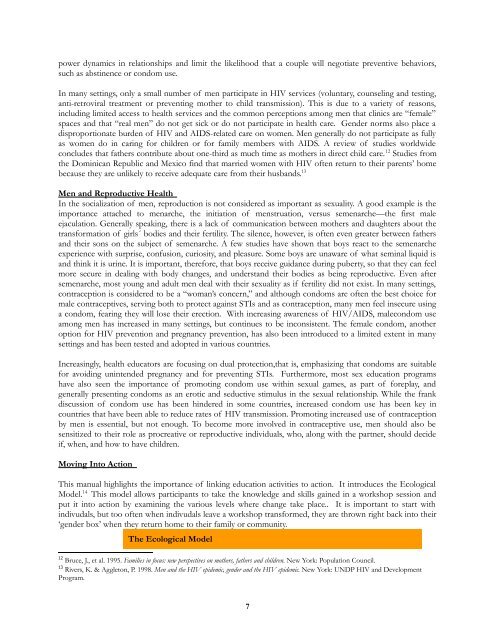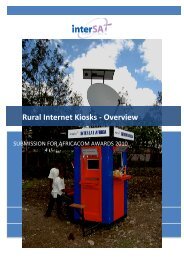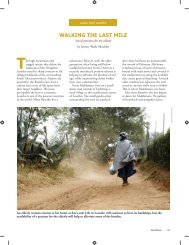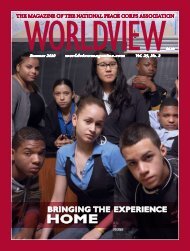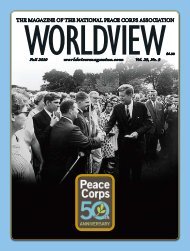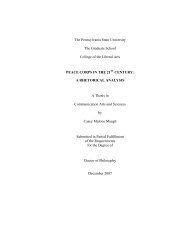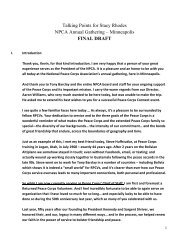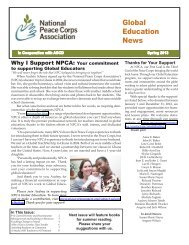Group Education Manual - Peace Corps Wiki
Group Education Manual - Peace Corps Wiki
Group Education Manual - Peace Corps Wiki
Create successful ePaper yourself
Turn your PDF publications into a flip-book with our unique Google optimized e-Paper software.
power dynamics in relationships and limit the likelihood that a couple will negotiate preventive behaviors,such as abstinence or condom use.In many settings, only a small number of men participate in HIV services (voluntary, counseling and testing,anti-retroviral treatment or preventing mother to child transmission). This is due to a variety of reasons,including limited access to health services and the common perceptions among men that clinics are “female”spaces and that “real men” do not get sick or do not participate in health care. Gender norms also place adisproportionate burden of HIV and AIDS-related care on women. Men generally do not participate as fullyas women do in caring for children or for family members with AIDS. A review of studies worldwideconcludes that fathers contribute about one-third as much time as mothers in direct child care. 12 Studies fromthe Dominican Republic and Mexico find that married women with HIV often return to their parents’ homebecause they are unlikely to receive adequate care from their husbands. 13Men and Reproductive HealthIn the socialization of men, reproduction is not considered as important as sexuality. A good example is theimportance attached to menarche, the initiation of menstruation, versus semenarche—the first maleejaculation. Generally speaking, there is a lack of communication between mothers and daughters about thetransformation of girls´ bodies and their fertility. The silence, however, is often even greater between fathersand their sons on the subject of semenarche. A few studies have shown that boys react to the semenarcheexperience with surprise, confusion, curiosity, and pleasure. Some boys are unaware of what seminal liquid isand think it is urine. It is important, therefore, that boys receive guidance during puberty, so that they can feelmore secure in dealing with body changes, and understand their bodies as being reproductive. Even aftersemenarche, most young and adult men deal with their sexuality as if fertility did not exist. In many settings,contraception is considered to be a “woman’s concern,” and although condoms are often the best choice formale contraceptives, serving both to protect against STIs and as contraception, many men feel insecure usinga condom, fearing they will lose their erection. With increasing awareness of HIV/AIDS, malecondom useamong men has increased in many settings, but continues to be inconsistent. The female condom, anotheroption for HIV prevention and pregnancy prevention, has also been introduced to a limited extent in manysettings and has been tested and adopted in various countries.Increasingly, health educators are focusing on dual protection,that is, emphasizing that condoms are suitablefor avoiding unintended pregnancy and for preventing STIs. Furthermore, most sex education programshave also seen the importance of promoting condom use within sexual games, as part of foreplay, andgenerally presenting condoms as an erotic and seductive stimulus in the sexual relationship. While the frankdiscussion of condom use has been hindered in some countries, increased condom use has been key incountries that have been able to reduce rates of HIV transmission. Promoting increased use of contraceptionby men is essential, but not enough. To become more involved in contraceptive use, men should also besensitized to their role as procreative or reproductive individuals, who, along with the partner, should decideif, when, and how to have children.Moving Into ActionThis manual highlights the importance of linking education activities to action. It introduces the EcologicalModel. 14 This model allows participants to take the knowledge and skills gained in a workshop session andput it into action by examining the various levels where change take place.. It is important to start withindivudals, but too often when indivudals leave a workshop transformed, they are thrown right back into their‘gender box’ when they return home to their family or community.The Ecological Model12 Bruce, J., et al. 1995. Families in focus: new perspectives on mothers, fathers and children. New York: Population Council.13 Rivers, K. & Aggleton, P. 1998. Men and the HIV epidemic, gender and the HIV epidemic. New York: UNDP HIV and DevelopmentProgram.7


